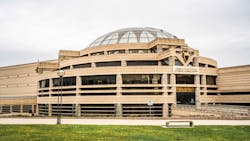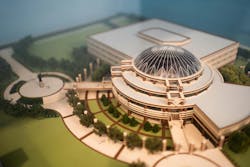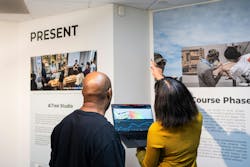How the Wright Museum’s Digital Transformation is Leading the Way for Sustainability in Museums
The buildings industry is in a watershed moment. As smart building technologies continue to flood the market, owners and facilities directors who embrace this sea change are positioning their assets to realize greater efficiencies and savings than ever before, all while making significant strides in achieving their environmental goals.
Cultural institutions like museums have a unique opportunity to not only embrace digital transformation, but also to educate the public at large and to serve as models for sustainability to other institutes around the country.
That was certainly the case with the Charles H. Wright Museum of African American History in Detroit, which has undertaken a groundbreaking digital transformation to emerge as a “smart museum” with a goal of cultural preservation and community impact. Celebrating its 60th year in 2025, the Wright Museum is one of the first and oldest African American museums in the U.S. and has been instrumental in founding nearly 300 similar cultural institutions across the country.
“This is a very prominent space with a lot of history in Detroit,” said Leslie Tom, chief sustainability officer for the Wright Museum. Founded in 1965 by Detroit obstetrician and gynecologist Dr. Charles H. Wright, the museum has as its mission to create a space for “celebration and remembrance.” Its foundation is directly tied to the local community, with Dr. Wright having delivered more than 7,000 babies whose lives along with their mothers are part of the fabric of the museum and why it was founded, Tom noted.
Built in 1997, the 125,000-square-foot space includes a permanent exhibit that brings visitors on an immersive journey through various art galleries and rotating exhibits that showcase historical periods, enriching experiences, and sustainability projects to foster learning and engagement.
Rooted in Sustainability and Education
It’s widely known that buildings account for nearly 40% of all global greenhouse gas emissions annually, but a lesser-known fact is that climate changes linked to global warming have a disparate impact on the health of people of color, including children, according to the National Institutes of Health. In light of this, the Wright Museum has made it its mission to educate the public on these disparities and to lead by example in becoming a truly smart and sustainable museum.
“There’s definitely a green museum movement happening,” Tom said, noting that there are more than 35,000 museums in the U.S.—greater than the number of Starbucks and McDonald’s restaurants combined. She said museums are asking themselves how they can begin to better align their missions and to ask what role museums can play in the climate crisis.
“I think some of the work we’re doing here at the Wright Museum is to answer some of those questions and to give examples of what’s possible,” she said. “It’s really pushing that edge of, what can we do? And how can we also take a museum and start teaching other museums, other spaces, other building owners how to be a player in climate crisis?”
Given that heating and cooling make up such a significant portion of a building’s energy use and carbon emissions, the Wright Museum has taken a comprehensive approach to its sustainability targets to address maintenance, operations, and renovations while leveraging smart technology to meet its targets.
The Digital Transformation: From Reactive to Proactive
“Charles Wright had a vision for what they wanted to achieve around being more sustainable, moving from a very reactive maintenance to proactive maintenance [approach], but also, really how they could set an example of being a much more sustainable museum of the future,” said Robert Bray, vice president and general manager for Autodesk Tandem.
To get there, however, required the ability to access, collect, and analyze operational data by leveraging digital twin technology. Given that digital twin technology is still an emerging field, Bray said the Autodesk Tandem team acted as “a trusted advisor” while it undertook its digital transformation journey. But creating a digital twin of the building proved to be no simple task.
“One of the challenges Charles Wright had was the fact that the architecture firm that designed the building many years ago burned down, and they lost all of their architectural plans,” Bray recalled. A contractor was brought in to laser scan the entire building and convert it into a detailed 3D model, which would serve as the foundation of the digital twin.
The project team was able to identify various sensors the museum could install within the building to track the facility’s occupancy and environmental conditions “to help them solve and identify some use cases around tracking visitor engagement in the galleries, for example—super important to a museum to understand—and work towards understanding their current journey towards sustainability, energy, consumption, carbon emissions, things like that. That’s still kind of a work in progress,” Bray explained.
After creating the digital twin, the Wright Museum integrated IoT sensors and began to collect and analyze data to optimize their operations. Autodesk’s Tandem software then took the data from these sensors and allowed the museum to measure, track, and document a wide range of inputs. In their initial pilot, the Wright Museum is using sensors to monitor CO2 levels, humidity, temperature, and proximity, for example.
Bray added that Autodesk also helped the museum move away from a reactive, paper-based maintenance program to a more proactive methodology that would help it better understand its maintenance schedules and get out in front of potential component failures and begin to predict them in the future.
A Better Experience for Facilities Staff and Visitors
The transformation of the Wright Museum into a smart facility has proved beneficial for both the facilities staff and visitors alike.
On the operations side, every facilities manager is painfully aware of the phenomenon known as “alarm fatigue,” which happens when a person is overwhelmed by experiencing a large number of alerts that can lead to desensitization and delayed or missed responses. Fortunately for the Wright Museum staff, Autodesk’s software integrates with their operational technology to reduce these instances.
Bray offers the example of a faulty piece of equipment that’s having a reading that’s out of tolerance or a server room that’s suddenly above its normal operating temperature and continues exceeding the threshold. “What we are enabling is the ability to basically automate the creation of a work order in whatever their system of record is so that a technician gets assigned to go inspect that so there’s no user intervention required,” he explained.
For these known anomalies, a technician can view the historical maintenance data in Tandem to determine if it’s a new anomaly or a recurring issue, and then decide what the right course of action might be, Bray said.
Visitors may not be aware of the fact that they are contributing to the museum’s improvements, but simply by exhaling, they are providing staff with valuable information. Utilizing carbon dioxide sensors in the building, the Wright Museum can measure patron engagement by how long they are lingering in a particular exhibit without any privacy concerns. The data can also help the museum protect its valuable artifacts and better understand how visitors move through a gallery for future installations.
More importantly, the Wright Museum is educating the public about its mission as a smart museum that inspires visitors and other institutions to take meaningful actions to be more sustainable.
“I often say that for the museum, we’re expanding the triple bottom line to be ‘people, planet, prosperity, and programs,’” Tom said. “How the museum can help to shape all of those different things from policies to technology to processes, and then eventually, that will lead to people’s experiences.”
By embarking on this digital transformation journey, the Wright Museum now serves as a beacon to the industry and its community of what meaningful change can look like.




